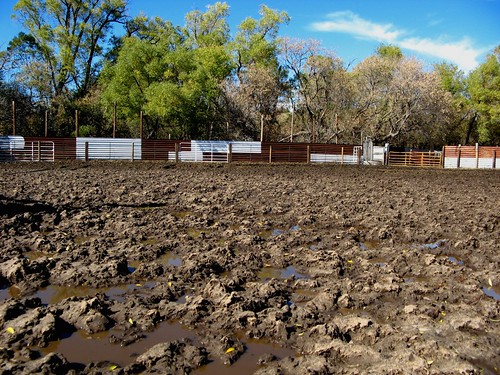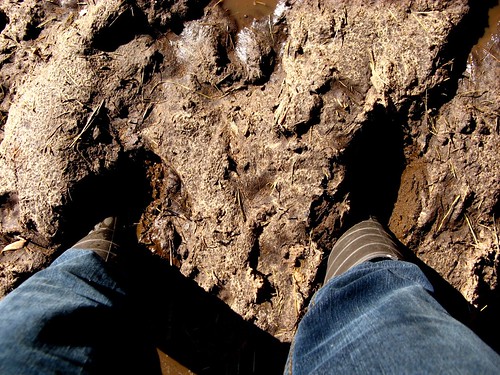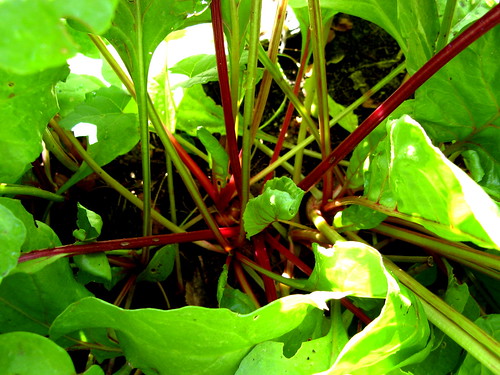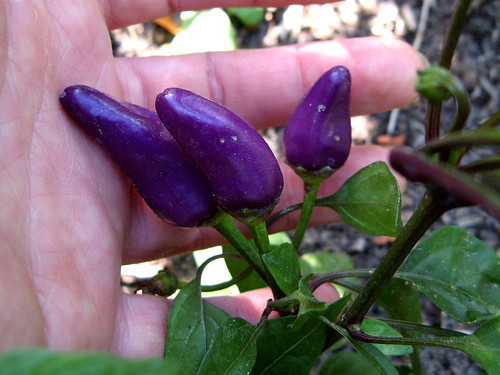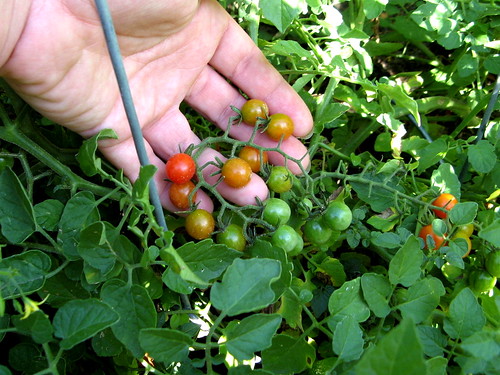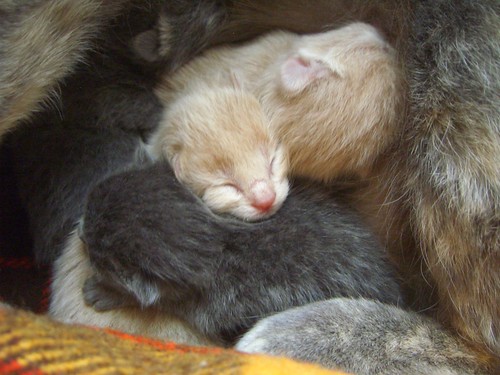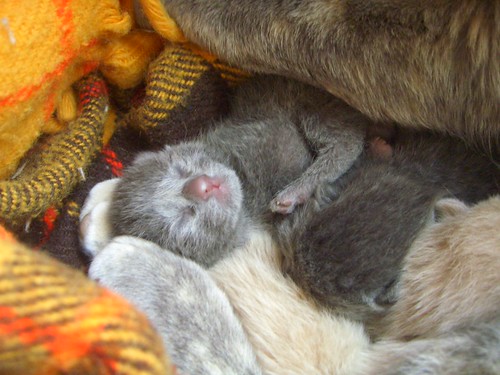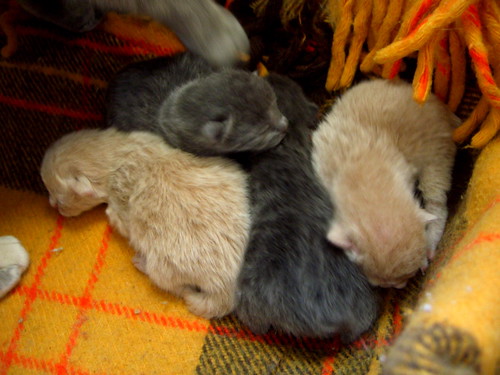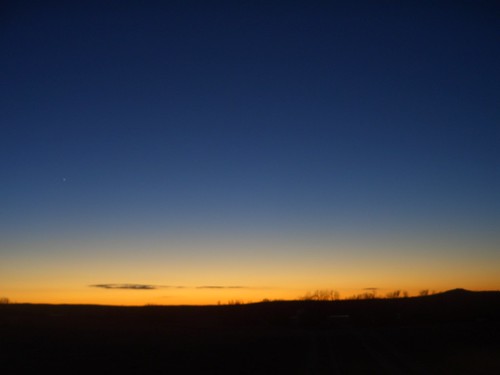With calving season just around the corner and everyone up to their a** in alligators already, I offered to help out by learning to feed hay. But there were a lot of new things for me to learn before I could actually be of help. So Dad started my tutorial last weekend.
First of all, I had to learn how to drive the tractor with the loader up front and pulling the haysled behind: where to drive (and more importantly where NOT to), how fast to go (how SLOW - never more than 5 mph), when to engage the 4-wheel drive, when to lock the back wheels together (and more importantly when not to), how to use all the hydraulics. Then there is an even more complicated level of decision making: how much hay to feed each bunch of cattle, where to feed it when there is a storm coming, how to feed it when the wind is blowing hard, how to judge if I fed them enough the day before or if I should feed more (or less) next time, when to feed the 'good' hay and when to feed the 'bad' hay, and how to tell the difference between the two.

On my first day we fed everything. It took almost 5 hours. That's a little bigger chunk of my day than I'd realized I was signing up for. We've decided to feed two days' worth at a time, so that will cut down on the daily time investment considerably. And George has been working on all the gates, many of which were constructed in such a ridiculously absurd manner that it took me ten minutes to get everything just right so it would fasten. Plus, with experience I'm sure I'll get more efficient overall and might only need to spend 2-3 hours a day feeding.
But the naive excitement that I had at first is waning somewhat now. I'm still totally committed to getting good at this new job and glad to be helpful. But the anxiety, which I expect (and hope) will diminish with time, is exhausting. The dimensions of the tractor and hay sled, coupled with the incredible weight of the hay stacks is overwhelming. The setup is deceptively fragile - so many hydraulics and such tremendous loads. [Hay is a lot heavier than it looks.] I can't trust my instincts when working at this scale - all the unconscious behaviors gained from 20 years of driving experience must be forgotten, for the most part, and relearned. So far I haven't done any serious damage, but that's not to say I haven't come uncomfortably close to doing so. I'm definitely one of the unfortunate who learn best from mistakes rather than successes. Luckily, a 'close call' will usually suffice.
I'm starting to feel pretty confident just driving and nearly have a sensation for the path and movement of the haysled behind me. It has taken me a while to realize that I need to plan my movements WAY ahead of time. If I turn too sharp, or not sharp enough, it would be possible to get 'trapped' in a position that would require drastic measures to remedy (like having to take out a fence, for instance). The ground is froze hard still, and I know it will drive differently once the frost goes out. I try not to worry, but I'm nervous about getting stuck. This is our biggest tractor, i.e. if it gets stuck we're screwed, because it's going to take something even bigger to pull it out. On the up side, I don't think I'm at risk of becoming over-confident anytime soon.
The one thing I may never get comfortable with is driving on the side of a hill. I sense that my threshold for tilting sideways is much lower than most people. I used to cower under the dash when I was little and dad was driving on steep terrain. And strangely, I seem to have a much higher tolerance for tipping to the left than to the right. My fears ARE somewhat justified - the tractor is pretty top heavy and tipping over would be a disaster. But the bottom falls out of my stomach with just a few degrees of tilt and it really isn't possible to avoid such situations.

The hydraulics for the hayfork seemed a bit overly-complicated at first, but I've pretty well gotten the hang of it now. (There are three hydraulic controls for the loader up front, four controls for the hayfork. plus an auxillary switch that creates several more permutations - hydralics for the haysled and the chains.) I tend toward the (secretly) perfectionist parts of my personality in the task maneuvering the hayfork, which I really need to get over unless I want to spend oodles of extra time just for the sake of aesthetics. There are a few controls that are a bit touchy, but overall I'm pretty decent at forking off the hay. It's actually a pretty fun job, though I think I'd enjoy it a lot more if you didn't have to crane your neck around backwards to see what you're doing.
So I can drive the tractor, I can fork off the hay - sounds pretty solid, right? Except that I'm still completely incompetent in one vital task: loading the stacks. We feed about one big stack a day, so a new stack has to be loaded onto the sled once or even twice a day. I've been lying in bed at night going over and over the procedure (which I've really got to stop doing because these are not sleep-inducing thoughts, to say the least). Maybe it would help if I wrote them out.
Here are the essential steps to load a haystack onto the haysled, IF everything goes smoothly (which, at this point, would basically take a miracle):
1. Pull into the stackyard, driving alongside the stack you intend to pick up, and then pull as far past it as you have room to do.
(If you're entering the stackyard from a pasture where there are cows, you'd best make sure you can feed them some hay beforehand, so that they won't try to follow you into the stackyard. Basically, that would be a disaster - ridiculously hard to get them out again, plus then they'll be on to your stash and more likely to break in later on.)
2. Back up to a stack, being careful to be centered and squared-up with the stack and trailer both.
(Sounds easy enough, but this is my number one weakness. Backing up a huge trailer makes me feel like a total dumbass. I'll think I've got the wheels cranked the right way, but then the trailer will go the wrong way because I'm past the 'fulcrum'. I'm a mess at backing up. A complete disaster. Not only is everything backwards from the way I expect it to be, I'm also facing backwards. And if you think two 'backwards' make a 'rightwards' you'd be SO wrong.)
3. Put the tractor in park and throttle down.
4. Flip the auxiliary switch to the 'neutral' position.
5. Use the joystick buttons (of which there are three, each with two directions) to move the hayfork well out of the way - up and off to the side.
6. Flip the auxiliary switch to the 'forward' position.
7. Push the joystick forward, to change the direction of the chains.
8. Test to make sure the chains are now moving in the right direction.
(towards you, so that they will pull the stack onto the trailer)
9. Flip the auxiliary switch to the 'rear' position.
10. Use the joystick to tilt up the bed of the haysled, until the wheels just start to come off the ground.
(It is very important to leave the auxiliary switch in THIS position.)
11. Flip on the 4-wheel drive lock.
(12a. Go through the remaining steps in your head because they all happen at once, much faster than is really comfortable.)
12. Put the tractor in the A range, if not already, and the 1st speed.
13. Engage the chains.
14. Release the clutch and start reversing into the stack.
15. As SOON as you're under a bit of the stack, press the joystick ALL the way forward, to the 'float' position.
(This will let the bed tilt back down as the weight of the stack moves forward, prevent the back of the sled from digging into the ground, and reduce the strain on the sled hydraulics. Incidentally, this has so far been impossible for me to remember to do, mostly because I'm preoccupied with step 16...)
16. It will be necessary to 'slip' the clutch to keep the tractor moving back at the same speed that the chains are moving forward. If these two speeds do not match up, the stack will come apart. The tractor tends to backup faster than the chains move forward, so you have to watch the front edge of the stack and slip the clutch if you see the front bit of hay rolling back underneath the stack as you go.
17. Stop the tractor once you've got the stack completely on the haysled.
(This you just have to develop a sense for. Hypothetically, it would be possible to stop the chains and the tractor and go see where you're at, but ideally you can just intuit this without the trouble.)
18. Stop the chains once the stack is nearly to the front of the sled.
(You don't want the stack too far forward because it will get wrapped up in the PTO shaft, but you need some 'tongue weight'. This can easily be adjusted after getting out and and inspecting the situation. It seems best to move the chains/stack forward until the bed is completely flat, then move it another foot or so forward.)
19. Take a deep breath and give yourself a pat on the back. (Alternatively, have a swig of whiskey and rest your forehead on the steering wheel until you can breathe again.)
20. With the stack "perfectly" loaded, you can drop the hayfork onto the new stack and grab a bite of hay with the claw to stabilize it.
21. Switch off the 4-wheel drive and head out.
(If you are situated right next to another stack - which is nearly always the case - it is VERY important to pull out straight until the sled clears the stack next to it. Apparently, the pressure of turning too quickly - pressing into the other haystack - could be so tremendous as to BEND the haysled.)

Tomorrow will be my first solo attempt. I drove out to the stackyard this afternoon and Dad helped me load a stack (see the pictures above - not bad, eh?). After I feed the cows tomorrow, I'll load another - by myself.



